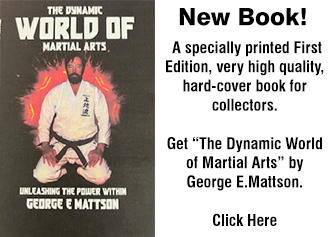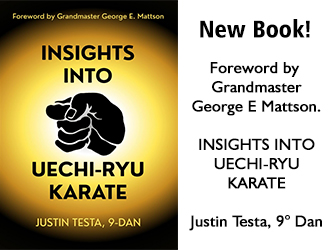From Nidan to Sandan, Virtually.
By Dan Maestas
We, as a society, have become extremely reliant on a virtual world. Many products and services are offered and delivered from a nonexistent entity, the internet. Sports fans play fantasy sports, businesses conduct virtual meetings and students can even get a college degree online. But what about learning karate via a virtual dojo, is it possible to learn an art by some remote method and become proficient. That is what George Mattson set out to find out when he started the Mattson Academy Virtual Dojo and I was one of his first students to give it a try.
I started studying Uechi Ryu in 1990 under the instruction of Steve Vosa (please excuse the informality, no disrespect is intended by referring to him by his name). Steve Vosa was an excellent teacher and under his instruction I earned up to the rank of Nidan. After earning the rank of Nidan, my martial arts training seemed to plateau. There were a lot of factors which contributed to my plateau. Some of it was time constraints and other factors were mental or physical. Needless to say I grew frustrated and decided to take a hiatus from martial arts.
During my hiatus from martial arts, I always practiced a little. I primarily did it so I wouldn’t forget the sequence of techniques. I wasn’t working to improve or test for another rank; I was simply existing. The problem with falling into this mode was I basically became a robot, doing the same movements I learned in the kyu ranks. Needles to say I became a very crappy martial artist. One day in 2007, I finally decided I wanted to study Uechi Ryu again. I tried to improve but all I was doing was improving my crappy technique. Don’t get me wrong, to the untrained eye, I started in the right position and ended in the right position and I didn’t look half bad but it was all an illusion. That’s not what I wanted, I wanted my karate to be powerful, I wanted it to be efficient and most importantly, I wanted it to be effective.
After several months of trying to improve, I received an email advertising George Mattson’s Virtual Dojo. He was offering an introductory rate for his new Virtual Dojo. I thought, what the heck it’s a reasonable price and I get to communicate personally with a great martial artist. If nothing else, maybe it would buy me 10 minutes of his time at Summer Fest. I was a skeptic, but I was also desperate to improve. Despite the fact that I was a skeptic, I also started the program with an open mind. What good was it to enroll in the program if I was going to spend all my time trying to justify my bad technique? This mindset was critical to what I will call my success.
We started the program, doing what every black belt wants to do (this is definitely meant to be sarcastic), by going back to the basics. This was a blow to my pride but if my technique was bad it’s because it had a really good start and the best way to fix the problem was to start from the beginning. I sent my first video of Sanchin to George (again please see my disclaimer above) and in typical George fashion I received an, “It’s not bad but…” And so my journey began. This was would be a common anthem for the first year and a half. There were many days when I was extremely frustrated and there were many days when quitting crossed my mind but just when I thought about throwing in the towel, I heard those magic words from George, “That is a huge improvement.” So what made the difference?
I mentioned having an open mind and a positive attitude, but that will only go so far. What really makes a difference is the training method. For those who are unaware, virtually training is conducted by videotaping techniques and sending them for evaluation. For those who may be skeptical, as I was, and think video cannot help a karate student with their training, all I can say is the video camera doesn’t lie. The camera catches everything from strengths to weaknesses. Videotaping your karate workout, even if you’re not a virtual student gives a different perspective. It can be slowed way down to see the movements between the movements, as George would say. This is where poor technique really lies. Something as simple as a block starting too early or an arm extending too far can have a huge impact on effectiveness, efficiency and power. With George’s help and evaluation of my videotapes, I was taught how to work on these problem areas and fix them. As the movements between the movements improved, so did my technique.
After nearly 3 years as a virtual student, I have come a long way. I am starting to notice my techniques are becoming more powerful and I am becoming a more efficient fighter. I also feel like I may one day I may be a very effective karate student, but after all, I am still a karate student and I still have a lot to learn. This weekend I had the privilege of visiting with George Mattson and Tim at his dojo in Mt Dora. After years of sending videos, it was great to receive instruction in person. Visiting and studying with George is like being spoon feed with a fire hose. He has so much to teach that it’s difficult to take it all in, in such a short period of time. This is when you truly realize you have a long way to go.
This brings me to the downside of virtual training. My technique improved, in my katas, but two-person drills are virtually nonexistent in a virtual dojo. It is difficult to practice the kumites and bunkai without a partner. This is where effectiveness is impacted. Many times I was instructed to envision a partner but working with an imaginary friend really doesn’t stack up to working with a real attacker, so to speak. It’s difficult to lead with an attack, when there is no actual threat or determine when an attack ends and the counter attack begins without a physical partner. The second problem with an imaginary friend for a karate partner is the lack of ideas or analogies which make a technique click in the mind.
Prior to my visit I struggled with my kicks. On the surface, kicking should not be a difficult task but to kick effectively requires practice and training. In Mt Dora, I had the pleasure of meeting one of George’s students, Tim Dando. Tim gave me the analogy that kicking should feel like, when you try to fling a flip-flop off your foot. While I don’t expect readers to understand, to me it made all the difference. My brain now has a visual reference and I have no doubt it will greatly improve my kick. This would not have been possible without my visit to Mt Dora and the few hours I spent with Tim. In a dojo, every student brings something to the table which could be a tremendous benefit to everyone. Without Tim’s suggestion, I would still be struggling with that kick. Thanks Tim.
Karate is easy to learn but difficult to master. Many students spend a lot of time and money learning movements but never truly grasp the techniques. For students who do not have an opportunity to continue studying in a dojo, a virtual dojo can provide an excellent opportunity to improve their technique. This is exactly what my experience has been. Learning the movements between the movements has improved most of my techniques and made me a better karateka. My karate improved so much by attending George Mattson’s Virtual dojo that not only did my karate improve, it directly resulted in my recent promotion to Sandan. To all the skeptics all I can say is give it a try you just might learn something.





